
MAY CONTAIN NUTS

Search Shorpy
SHORPY ART

Framed or unframed, desk size to sofa size, printed by us in Arizona and Alabama since 2007. Explore now.
Join and Share
Ad-Free Shorpy
Shorpy is funded by you. Patreon contributors get an ad-free experience.
Learn more.

Recent comments
- Baldwin 62303
- Baldwin VO-1000
- Cold
- No expense spared
- Tough Guys
- Lost in Toyland
- And without gloves
- If I were a blindfolded time traveler
- Smoke Consumer Also Cooks
- Oh that stove!
- Possibly still there?
- What?!?
- $100 Reward
- Freeze Frame
- Texas Flyer wanted
- Just a Year Too Soon
- WWII -- Replacing men with women at the railroad crossing.
- Yes, Icing
- You kids drive me nuts!
- NOT An Easy Job
- I wonder
- Just add window boxes
- Icing Platform?
- Indiana Harbor Belt abides
- Freezing haze
- Corrections (for those who care)
- C&NW at Nelson
- Fallen Flags
- A dangerous job made worse
- Water Stop
Member Photos
The Shorpy
Print Emporium
Print Emporium
Search Shorpy
Search results -- 30 results per page
- Saturday in Florence: 1942
- June 1942. "Florence, Alabama, Saturday afternoon." Medium format acetate negative by Arthur ... 1942 model year was 40,661 cars. - Dave]
Florence, Alabama My grandmother gave me a cast iron skillet (that had been her ... did it all go?
Bruce
Saturday afternoon, Florence, Alabama A much simpler time, what a fantastic picture. It could be a Norman ... Posted by Dave - 10/01/2023 - 8:49pm -
![Saturday in Florence: 1942 June 1942. "Florence, Alabama, Saturday afternoon." Medium format acetate negative by Arthur Rothstein for the Office of War Information. View full size.
This pic is great!I love all the detail. It makes me wonder where everybody in the pic is today? Wonder where they were going? Love the contrast!
Stop and GoTraffic lights sure have become more elaborate since then. You would have trouble getting such a clear shot at a big intersection like that these days without a bunch of poles and signals getting in your way.
Majestic TheaterFrom Movie Theater Information:
The Majestic opened Saturday, August 30, 1919, at 204 North Court Street next to the new First National Bank. It's not clear what was shown on opening day, but the primary advertisements announced a Paramount Artcraft Special -- a motion picture style show with living models called "That Well Dressed Look" for September 1 and 2. The theater seated 400. The last night of business seems to have been June 9, 1951.
1945/ 46 HudsonThe Hudson in the center of the photo is a 1945 or 1946.
[Nope. It's a 1942 Hudson. - Dave]
AwesomeWonderful scan . . .Bravo!
Foy
Isn't this great?Isn't this great? Women wore skirts, and you could drive a car called Hudson.
1942 HudsonIt seems to me that a 1942 Hudson would be a relatively rare beast. I realize that production and sales on the 1942s started in September 1941, but they'd still have a shortened production run once the government ordered a halt to new automotive production because of the war.
[Total Hudson production for the 1942 model year was 40,661 cars. - Dave]
Florence, AlabamaMy grandmother gave me a cast iron skillet (that had been her mother’s) that was made in Florence. Some of her family had moved from that area in the 1850s, and I’ve always wondered if that skillet is that old or not. Whatever the case, I made some cornbread in it the other night, so it's still working fine, however old it is.
A Super pictureEven though WW II was raging, the picture show a gentle perhaps kinder time. People socializing, cars washed, traffic rules obeyed, clean streets, just great. Where did it all go?
Bruce
Saturday afternoon, Florence, AlabamaA much simpler time, what a fantastic picture. It could be a Norman Rockwell painting.
Florence, Alabama This is my hometown and the hometown of my parents and grandparents. This picture had to have been taken from the old courthouse, which is long gone, but the buildings in the picture still exist!
I wishI wish it looked that good today! I live less than a mile from where this was taken. I would love to see that many people walking and socializing on the sidewalks again.
Looking for somethingI'm looking for an old pic of THIS area right here, only its older (I'd say late 1800's) it's b/w and shows horse troughs on the ground below where traffic lights now hang. Tennessee / Court street. Anyone know about it?
if so:
patrickseth81@yahoo.com
Court & MobileThis is the corner of Court and Mobile in downtown Florence. The camera seems to be perched in the old Rogers Department Store building. The modern Street View image is sadly not as interesting, though the City Cafe building and the building just to its left are both still standing today. I was born and raised in Florence. It's a great place to live, and downtown has fared a lot better than many cities its size.
(The Gallery, Arthur Rothstein, Cars, Trucks, Buses, Small Towns)](https://www.shorpy.com/files/images/8e05094u1.thumbnail.jpg)
- Woodville, Alabama - June 1942
- ... from an original slide made in June 1942 in Woodville, Alabama. The photographer's name is Wendell Page. The photo is believed to ... college professor. View full size.
Woodville, Alabama What a great photo! Shorpy loves scans of color slides.
... Posted by dderrick - 05/31/2007 - 8:33pm -
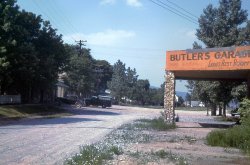
- Sprott, Alabama: 1936
- August 1936. "Crossroads store at Sprott, Alabama." 8x10 inch acetate negative by Walker Evans for the Resettlement ... Posted by Dave - 12/28/2022 - 12:09pm -
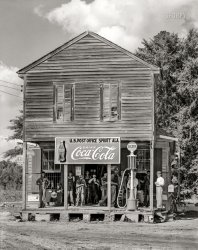
- Gadsden Shoppers: 1940
- ... December 1940. "Christmas shopping crowds. Gadsden, Alabama." Medium format acetate negative by John Vachon for the Farm Security ... One wonders about what is being said, in 1940's Jim Crow Alabama.
Fur in Alabama Sure doesn't look cold enough for fur, based on ... Posted by Dave - 04/06/2021 - 3:31pm -
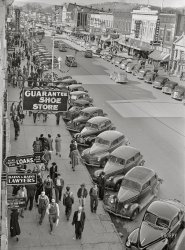
- Selma, Alabama: 1935
- December 1935. "Sidewalk scene in Selma, Alabama." 8x10 inch nitrate negative by Walker Evans for the Resettlement ... I could use this photo for my project. My mom is from alabama so this is how it used to be back in the day. It used to look so ... Posted by Dave - 05/14/2019 - 10:27am -
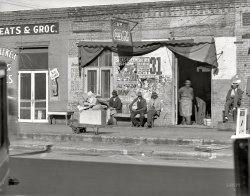
- Sweet Home Alabama: 1935
- December 1935. "Sidewalk scene in Selma, Alabama." Large-format nitrate negative by Walker Evans for the Resettlement ... grandpa tells me about the depression. (Albeit in NYC, not Alabama)
More Than Documentary What a superb photograph. What wonderful ... Posted by Dave - 03/22/2009 - 10:53pm -
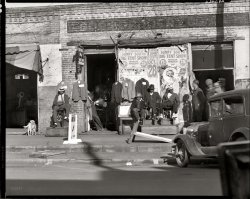
- Greensboro, Alabama: 1936
- "County seat of Hale County, Alabama," in August 1936 as photographed by Walker Evans. View full size. ... Posted by Dave - 08/03/2012 - 11:35am -
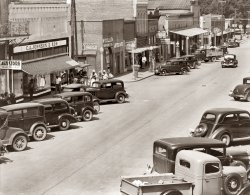
- Alabama Gothic: 1939
- ... 1939. " Knight House , Greensboro vicinity, Hale County, Alabama. Gothic Revival two-story frame built c. 1840." A little dilapidated, ... Posted by Dave - 06/09/2018 - 7:45pm -
![Alabama Gothic: 1939 1939. "Knight House, Greensboro vicinity, Hale County, Alabama. Gothic Revival two-story frame built c. 1840." A little dilapidated, but it has good bones. Possibly under the porch. Photo by Frances Benjamin Johnston. View full size.
Demolished?In using my fledgling Internet research skills, I think this is the Wemyss-Knight house and no longer extant? It does appear that there were several Knight homes in the Greensboro area photographed by Johnston.
I wonder if it was still inhabited at the time of the photo- cot on the porch, the rocking chair and other chairs suggest so but the crude bars on the shutters are depressing and that side porch sure looks like it wants to crumble away.
Unless I am mistaken there are two difference widths of the boards in the siding suggesting possible repairs at some point? The barge boards also look remarkably well kept for a 90 y.o. home- replaced at some point?
Beautiful bones, though- American Gothic vernacular had a unique charm.
IntricateSo many wonderful little details that just sing. The gable trim, the finials, those amazingly steep roof pitches. A real gem when it was new; hope [wish?] it was still there. The name makes you think it just might be still charming folks today.
The WagonIt would take a lot of work and a lot of money, but that could be a beautiful house. But no matter how much work I put into it, the wagon would stay exactly as is.
Appealing Paint for American GothicBeautiful Carpenter Gothic. Brick around on a good 75% of the foundation, and shutters can be repaired. Just needs some paint.
Paint? Painting a Victorian house is done the same way today as it was in the 1800s and in the 1930s. The clapboards have to be scraped and sanded. Then, painting is done by a guy on a ladder with a brush. No roller and definitely no sprayer. The estimates for painting my 1902 Eastlake Style were between $24,000 and $30,000.
The Depression probably saw a bunch of houses with peeling paint.
The pitchWow what a great house, as posted previously. I would have to hire out the roofing project though, that roof is steep!!! Not to mention trying to flash the chimney right in the middle of those valleys.
Lightning rod reactanceThe spiraling of the lightning rod ground wire was a bad idea. It would produce inductive reactance that would likely cause the lightning current to flash over to an alternate path. But in those days people seem more concern with decorative flair than operational efficacy.
Would love to see what was in the attic.
Flush SidingIn response to Dee's musings about the exterior of this fascinating house, the
siding is original and has not been repaired. The front facade uses flush
siding (tongue and groove, just like a wood floor) which was popular in the
early and mid-19th century. The intent was to resemble more expensive
masonry construction, at least when viewed from a distance. The more
common and less expensive clapboard siding was used on the secondary
elevations. The bargeboard has survived because the design is less elaborate
than many of the era and shed water better than designs with lots of scrolls
and complexity.
(The Gallery, Bizarre, F.B. Johnston)](https://www.shorpy.com/files/images/SHORPY_00115a.thumbnail.jpg)
- Forest Brook: 1956
- ... senior high after we moved to Florida.
I wonder how my Alabama classmates would remember me now?
Yes, the Memories! I would ... Posted by Dave - 02/14/2013 - 7:14am -
![Forest Brook: 1956 November 8, 1956. "Forest Brook Elementary School, Hauppauge, Long Island. Classroom and teacher." For those of a certain demographic, this may strike a chord. Large-format negative by Gottscho-Schleisner. View full size.
We never did that.I grew up in the suburbs around Akron, Ohio, and we never had a bomb drill or duck-and-cover drill ever. All of my peers that grew up in other places had those drills, which has led me to a couple of possible theories. One, that we had some sort of pacifists in our local administration that refused to take part in the Cold War(unlikely). Or two, that we were so close to potential industrial targets that there was simply no point in hoping for survival... Better to go out in the first flash.
[Never had them in my grade school years 1952-1960 in Larkspur, California, either, nor was I aware at the time that they were going on anywhere. -tterrace]
Lighting fixturesWe had very similar fixtures in my Elementary School about ten years after this, ours had a large bulb with the bottom painted silver sticking through the center though.
They were probably ancient even in 1966.
X marks the spotI'm not sure if it looked that way in 1956, but Forest Brook today has a strange shape, what you might get if Picasso or Dali had been asked to draw the letter X.
Hauppague today is a densely populated community, home to most of Suffolk County's government (though Riverhead is the actual county seat) and a huge industrial park, but back in 1956 it was on the frontier of suburbanization. I wouldn't be surprised if some of the students in this picture were the children of farmers.
You will not leave this house dressed like thatIt would be three years before I entered first grade about 20 miles west of Hauppauge. The New York City Board of Education had a much less relaxed dress code. Boys from first grade on had to wear ties. Jeans and sneakers were not permitted. On school assembly day everyone was required to wear a white shirt or blouse and the boys had to wear red ties. Of course by the time we were graduating from high school there were still strict dress standards, but they only applied to the teachers.
Smelementary SchoolThose wooden desks were washed and cleaned before classes three months ago, and the floors are waxed weekly.
All the girls are in skirts or dresses, and the boys are well groomed and always polite. After all, no one wants to get called down to the school office!
Plus, there's a great lineup of cars out the window, in case a little daydreaming is in order, but only for a few seconds at a time. By the way, you can smell today's newfangled hot lunch almost ready to serve, down the hall.
Let there be photonsMy elementary school (Horace Mann in Burbank, Calif.) had the same light fixtures, although we had four to a room. Each contained one ≈500 watt bulb; the bottom of the bulb was obscured by a silver coating. When a bulb was nearing the end of its service life, it would usually emit a high-pitched squeal. The teacher would then cycle the light switch off and on several times, killing the bulb and throttling the distracting squeal.
Reading MaterialMost of the children have notebooks, many children seem to have the Spell and Write workbook, and the young man in the lower left (just behind the girl in the foreground) has the Air Raid Instruction booklet on his desk.
My First Year of School1956 was my first year of school in Houston. Would have loved to have been able to wear blue jeans and shirt tails out but HISD rules at the time (and almost all the way through my HS years) said no blue jeans, no t-shirts, no shirt tails out for boys and skirts/dresses only for girls.
Hard to believe especially since the schools weren't air conditioned in HISD except for offices and a few other classrooms (science for one)until after I graduated in 1968.
No duck and cover drills for us until the Cuban missile crisis when we were told Houston would be a first strike target due the refineries throughout the Houston area. We had an air raid siren right next to the window in my 5th grade class that went off each Friday at noon. I also thought to myself that if the Russians were smart they would attack at noon on Friday!
Star pupils or problem children?Teacher has all that space in front of the classroom for her desk but it's right up close to those pupils at the far end of the classroom. Even with the photographer present, the kids appear to be gazing out the window. Maybe she needed to be that close to keep their attention for any length of time. I wonder if modern medicine is overused in favor of such simple solutions.
Maybe I'll send the first grade picture (1960) from my Catholic school in New Jersey. It's a bright, clean classroom like the one shown here but it's packed tight with baby boomers, all in navy blue and white uniforms, with Sister in her black and white habit up front.
1956 RebelAlright, who's the non-conformist on staff who just had to park facing the wrong way?
Sturdy Desks and the "Good Old Days"Those sturdy desks are perfect for the inevitable "Flash Drills" of the era, in which the principal would come into the room unannounced and write "FLASH" on the blackboard, causing all of us students to "duck and cover" to avoid instant nuclear incineration. I'm not sure how much good it would have done in a real attack, but it was the only tool in the drawer.
Also, I'm surprised the windows don't have the standard heavy blackout curtains, which were handy not only for viewing nmovies but to keep enemy bombers from spotting stray lights at night.
And a decade laterI started public school a decade later, in a building constructed in 1961. And it was exactly like this, light fixtures, desks, and all. Most of the teachers were young then (and exactly one man, who I got in fifth grade) but I started out with Mrs. Lord, the white-haired wife of the principal, who could have stepped out of any 1910 school administrator picture with naught more than a change of collar. However in my day the fellow with the open shirt front there would have been made to neaten himself up.
Beautiful Schools but the Russians are coming!I began my second semester of kindergarden in January of 1953 in newly built grade school on the west side of Detroit. We immediately began having fire and air raid drills. For air raids we descended into the basement of the school which was actually the main tunnel of the air circulation system. Some times when we went down the stairs during a drill, the big fan would still be rotating after being shut down. We had to sit along the walls and cover our heads. To condition us further the lights would be turned off for a short period of time. I switched to a newly built parochial grade school for the fourth grade on. No basement, so we sat in the main hallway between the class rooms and covered our heads. Both schools had class rooms identical to Forest Brook. To add to the tension, the nearby Rouge Park had a Nike missile battery. The missiles were normally hidden behind a high earth berm, but they were visible when frequently pointed skyward for testing. The AM radio frequencies of 640 and 1240 were permanently etched into our memory.
DrillsI'm exactly the right age for these memories, but except for a few very early instances that were termed "air raid," all our drills were of the fire kind. No duck, no cover - and this just north of San Francisco, with its own battery of Nike missiles by the Golden Gate - in plain view if you took a spin along the Marin Headlands. We all just marched outside. The only time we had to put our practice to use was for a 1957 earthquake centered just south of SF but sharp enough in Larkspur to get us squealing in our fifth grade classroom before the alarm sounded and we made our orderly exit.
"Silver Tooth"I was in the ninth grade in fall of 56. All of the new schools I attended in the late 40's and 50's had those windows and the 9 inch floor tiles. I believe the teacher's desk was in that position only for this pic. One memory came to me in a flash when I saw the tiles. In the 4th grade on the last day of school as I was swinging between desks I did a face plant on the green floor tiles. The impact broke off two of my front teeth below the nerves and the family dentist fixed them with silver caps that stayed that way until I turned 21.
Blue Jeans?I was in 5th grade at the time, in a far western suburb of Chicago. What I remember was the enormous spending on shiny new schools back then. My mom was a teacher, back when teaching was a respected profession, teachers were proud of what they did for a living and grateful for the $6,000 a year they were paid.
That and the rule against blue jeans. Strictly verboten in my school system. They looked "hoo-dy", pronounced with "hoo" as the first syllable, and were a a well known precursor for the dreaded juvenile delinquency during adolescence and a life of crime and depravity later on. Without that rule, thank goodness and a vigilant school board, I probably would have a criminal record by now.
Good Ol' '56I was in third grade in Hempstead, Long Island then. Ike was president and the world 'champeen' Brooklyn Dodgers would win another pennant only to lose once more to the Yanks. Anybody who wore dungarees (as jeans were called then) in my school district would have been sent home to change to proper attire and an open shirt would catch you a stiff reprimand. Nobody knew what a school bus was and schools were not in the restaurant business for anybody. There was a lot to like about those days.
Fond MemoriesI was in 1st grade at that time and our classroom in suburban Chicago looked very much like this one. Someone mentioned getting called down to the office. There was nothing worse than hearing your name on the PA system to report to the principal. Every kid in school knew you were probably in deep doo doo. As for the non-conformist staff member who backed into his spot, these types have always been around and still are today. They'd rather waste extra time and endure the hassle of backing into a parking spot just so they can pull out with ease at the end of the day. Never understood that logic.
The Joys of childhoodI would have been 9 years old when this photo was taken. I was attending "Summer Avenue School" at that time. It was an old three story brick building. We had the kind of desks that bolted to the floor so they couldn't be moved even if you wanted to do so. The seat was actually part of the desk behind you and folded up automatically when you stood up. The top of the desk was hinged at the front so that you could lift it up and put you books and such inside. Oh Yes, they had the obligatory inkwell hole in them as well, but never any ink.
Summer Avenue School still stands but is now known as Roberto Clemente Elementary School.
The desksStarting I guess in the late 40s that blonde style of wood came very much into vogue for furniture. Notice, they're the first generation of school desk withOUT a hole for an inkwell. We had ball point pens by then, no more dipping a nub into india ink. And no more opportunities for dunking the pigtail of the little girl in front of you into the ink!
The furthest cornersAh, those desks. In the later grades of elementary school we ate our lunches in the classroom, and the kid in front of me used to stuff the parts of his lunch he didn’t want into the deepest recesses, behind books and other trash. It got very ripe, and one day the teacher followed her nose to Robert G.’s desk and made him excavate the smelly mess. I will leave the rest to everyone’s imaginations.
4th grade for meDecatur Street elementary. I think the building was probably built at the turn of the last century. And probably the teachers. We had the well worn student desks that you find in the antique shops now for a pretty penny. The one with the ink well and indentation for a pencil with the seat back and foldup seat on the front of your desk. We had 12' ceilings, oiled wood floors that the janitor put sawdust down on daily to use his pushbroom on, kept the dust down.
Old School, New SchoolI started the first grade in 1954 in rural Kansas. We were in a building that had been built in 1911 and only housed six grades. The 7th and 8th grades were in the high school. The bathrooms, the lunchroom, and the art room were all in the basement, and we had music in a one-teacher school building that had been moved into town and put behind the school. The 1911 building was probably a horrible firetrap, although there was a metal fire escape on the back from the second floor down. The district built a new school in 1956, and we moved in in February 1957, when I was in the third grade. It looked much like the one in the photo, except that we had metal desks. No dress code--nearly all the boys wore jeans. That 1956 building is still in use, along with the 1923 high school. Of ocurse, they house far fewer kids than they did then.
Several years laterI was attending a Catholic school in a much older building further west on Long Island -- still vividly remember our "duck & cover" drills as I was the smart-alack who asked how a wooden desk would keep us from burning to a cinder.
As for the cafeteria, no hot lunch then; if you forgot your brown bag (no lunch money; you were not permitted to leave the premises) you might have been lucky enough to be escorted across the street to the convent for a PB&J sandwich.
The uniforms were ghastly -- white shirt, dark maroon tie with the school shield on it, and dark grey slacks with black piping down the outside seam. Girls wore a white blouse with a snap tie, grey plaid skirt (that was always rolled up at the waist after leaving the house, and a matching bolero. Once out of sixth grade boys wore a blue plaid tie & girls could wear a -- *gasp* -- blouse of color.
Reminds me of another picture here of young girls wearing skirts in the dead of winter; evil little Catholic boys that we were, we'd spend the lunch hour in the schoolyard assaulting the bare-legged victims by snapping rubber-bands on their frozen legs.
Not non-conformism. Safety!I've worked at a school for years and even though I'm not much of a rebel, I've always backed into the parking space. The logic is simple: you have to back up when you arrive or when you leave, and it's safer to back *in* to a space when there are few or no children around (an hour or two before school starts) than to back *out* of a space when children are running all around at the end of the school day (of course, one should triple-check either time). I often back into shopping center parking spaces using the same reasoning: if there's no one around when I arrive, it's safer to back up then than later when there might be a lot of people about. I knew a man many years ago who fatally backed over his 4-year-old daughter in their driveway and that tragedy changed my thinking on this permanently.
Reminds me of...Sutton Elementary School, southwest Houston, 1971 to 1973. The building was built in the late 50s and had those same big windows, but by that time we had the one piece metal desks with the big opening beneath for your books.
Few years laterI was in the first grade in a Catholic school in NYC. We had fire drills but no under the desk kiss your butt goodbye stuff. Nuns ruled the roost in those days. Midget Gestapo agents all in black with a yardstick bigger than them which was used to get you back in line if you misbehaved. I remember the first day of 2nd grade while us kids were waiting for school to open and my mom approached me to wipe my nose and the nun smacked her hand saying "he belongs to us now!" Ah memories...
Patty Duke, Ben Gazzara, Gene Hackman were some of the actors who lived in the area, Kips Bay, and might have even attended my school at one time.
"Snaggletooth"I can sympathize with jimmylee42. I broke a front tooth in much the same way at my school in the fourth grade. It was the winter of '63-'64.
When the weather was exceptionally cold, they would open the gym for the early kids to come inside before classes started. Although the details are vague now, someone said I was tripped by a bully while I was running around. In a family of four siblings my folks couldn't afford to get my missing tooth capped for years. So one of my nicknames throughout grade school was "Snaggletooth"... not one of my fonder memories. I finally got a white tooth cap just before I started senior high after we moved to Florida.
I wonder how my Alabama classmates would remember me now?
Yes, the Memories!I would have been right in this age range, near as I can tell from looking at the kids. That would have made it my first year out of parochial school, escaped from 4th grade under the rule(r)Sister Rita Jean, she who was Evil Incarnate.
Best memory was teacher telling me, "David! Stop moving your desk around. It makes me think we're having an earthqu... Everyone - outside!!"
DaveB
WonderfulGrade school in Alexandria, Louisiana. Very familiar classrooms, with the good Nun up front to keep [or try to keep] us on the right path.
Bayou View SchoolThis reminds me of Mrs Powell's 2nd grade class at Bayou View School in Gulfport, Ms, c.1955.
Fast ForwardTwenty years later I attended a school built in the early 1940s. This reminds me of those old classrooms in some respects with the desks all lined up in rows, large windows and undoubtedly a large slate chalkboard just out of view. I notice that the teacher's chair is a sturdy wooden straight back chair - no comfortable office chairs here! Also, only a two drawer filing cabinet? I don't think I've ever seen one that small in a classroom. I teach school now and while this brings back memories (even the light fixtures), it's amazingly different today.
Green ThumbThe teacher has quite a spartan setup, but I love the line of flowers along the windowsill! What a lovely touch that would be in a classroom.
This was a fun photo and I enjoyed the comments. My parents were born in 1954 and I really like seeing and reading about what that might have been like.
I grew up in that town!I didn't go to this school, but grew up in Smithtown--where this school actually was; not Hauppauge. I was in elementary from 1990-1995, when times were much different. As a teacher I love seeing how it was then.
Love this photo but makes me sadIf I could push a button and go back in time and be someone someplace in the past, I'd be on my way to being one of the kids in that classroom. This is public school education when it was about education.
(The Gallery, Education, Schools, Gottscho-Schleisner, Kids)](https://www.shorpy.com/files/images/SHORPY_5a24730u.thumbnail.jpg)
- John Quill: 1910
- ... was termed her last trip.
Area: Mobile, Tombigbee and Alabama Rs.
Owners: built for Capt. John Quill and Moore, Mobile, Ala. ... for the Quill and Moore line on the Mobile, Tombigbee, and Alabama rivers. Her last trip was in 1928.
The second boat is the _y ... Posted by Dave - 08/14/2012 - 4:28pm -
![John Quill: 1910 Circa 1910. "Sternwheeler John Quill, packet steamer." 8x10 inch dry plate glass negative, Detroit Publishing Company. View full size.
Launched 1907, Destroyed 1928Launched: 1907, Jeffersonville, Ind. by Howard Yard
Destroyed: 1928, Feb., towed from Mobil to Twelve Mile Island on what was termed her last trip.
Area: Mobile, Tombigbee and Alabama Rs.
Owners: built for Capt. John Quill and Moore, Mobile, Ala.
Comments: 1916, June 12, Warrior R., hit rock and sank in 15' of water. LINK
Meet John QuillThe John Quill was built in 1907 at the Howard yards in Jeffersonville, Indiana. She was 168 x 35 feet. Ran for the Quill and Moore line on the Mobile, Tombigbee, and Alabama rivers. Her last trip was in 1928.
The second boat is the _y Staples.
[James T. Staples. - Dave]
Show BoatOne can almost hear a rich voice start to sing "Old Man River"
The John Quillran primarily the Tombigbee and Warrior Rivers in Alabama above Mobile, where this photograph was probably taken. Built by the famous Howard Shipyard at Jeffersonville, Indiana, for her namesake in 1907, she served that stretch of river until towed to Twelve Mile Island on the Mobile River (just northeast of Mobile) and dismantled there in 1928. The other vessel is the Jas. T. Staples, built 1908 at Mobile.
Alabama steamerThe "John Quill" was a common sight on the Mobile, Tombigbee, and Black Warrior Rivers, running north from Mobile to Alabama inland river ports such as Demopolis, Claiborne, and Tuscaloosa. Google it for links to lots of digitally archived photos of the steamboat in its working days.
Tired AlreadyThe John Quill looks pretty tired for only two years of service. Must have led a hard life. Note the interesting struts and tension cables designed to pull the ends up and keep the boat from "hogging" (rising in the middle), which increased drag and reduced fore and aft freeboard. I wonder if those were original or added later.
Jas. T Staples' ghost!Researching to find out why some steamboats have fluted stacks like the Staples in the distance, I came across this:
Visit any university campus in Alabama and someone there will tell you about the resident ghosts. One of the strangest ghost stories is the tale of the Captain Norman Staples. Captain Staples designed and built the most elegant riverboat on Alabama rivers and named the boat after his father, James T. Staples. From the moment of its maiden voyage in 1908, the riverboat James T. Staples was in trouble.
The large riverboat companies at the time were determined to put Captain Staples out of business and succeeded in doing so in 1912. On January 2, 1913, Captain Stapes committed suicide and three days later, his ghost began appearing on the deck of the riverboat. The crew, frightened by his apparition, quit and another crew had to be found. The new crew, although they knew nothing about the former Captain, reported seeing a ghost like man in the boiler room of the ship. Exactly one year, almost to the hour, the boiler of the riverboat blew up, killing the new captain and twenty-five members of the crew. Once the ships sank, local residents reported seeing Captain Staples' ghost standing guard over the graves of his four children in Bladon Springs Cemetery.
Chills up my spine!
(The Gallery, Boats & Bridges, DPC)](https://www.shorpy.com/files/images/4a16143a.thumbnail.jpg)
- Alabama Fried: 1941
- ... Sunday dinner for flying cadets at Craig Field, Selma, Alabama." Medium format negative by John Collier for the Farm Security ... Posted by Dave - 04/17/2016 - 12:53pm -
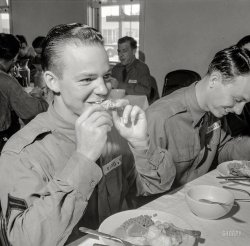
- Alabama Stop: 1937
- April 1937. "Coal miners' housing in Birmingham, Alabama." Photo by Arthur Rothstein for the Resettlement Administration. View ... Posted by Dave - 02/25/2017 - 3:15pm -
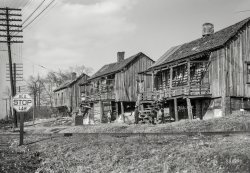
- Sweet Home Alabama: 1937
- April 1937. "Negro houses in Mobile, Ala." Our third dispatch today from Arthur Rothstein's trip south for the Resettlement Administration. View full size.
Lick o' Paint Okay, TON o'paint, and this would be interesting high-density ... Posted by Dave - 07/26/2014 - 11:22am -
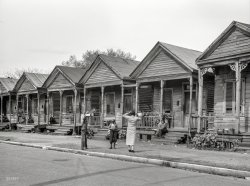
- Golden Jubilee: 1935
- ... December 1935. "Eagle's Store -- Selma, Dallas County, Alabama." 8x10 inch nitrate negative by Walker Evans for the U.S. Resettlement ... set on Gamma Tauri IV in the 24th century.
1119 Alabama Ave Corner of Washington Street. If you do a 360 on Street View, ... Posted by Dave - 01/21/2023 - 12:19pm -
![Golden Jubilee: 1935 December 1935. "Eagle's Store -- Selma, Dallas County, Alabama." 8x10 inch nitrate negative by Walker Evans for the U.S. Resettlement Administration. View full size.
The little parade on the sidewalkApparently they got tired of people coming in and asking how long they'd been in business.
They've arranged a cute display of kids' vehicles, but I don't know what that thing is at the end (the end opposite the trike). I'm not familiar with that wagon or whatever, with the handles sticking up. Anybody know what it is?
[Two wagons behind two wheelbarrows. - Dave]
Far-traveled titleThe movie showing at the Academy on Friday and Saturday is "The Last Outpost," released in 1935, starring Cary Grant and Claude Rains, and set in Kurdistan during World War I. Still to come: the 1951 film of the same title, starring Ronald Reagan and Rhonda Fleming and set in Arizona during the Civil War. Then in 1987, episode 5 of "Star Trek: The Next Generation," set on Gamma Tauri IV in the 24th century.
1119 Alabama AveCorner of Washington Street. If you do a 360 on Street View, you'll see this section of downtown Selma has seen better days.
The Eagle has landedThe building at 1119 Alabama Avenue still exists. But no more quality is delivered to customers here in the sign of the proud King of the Skies. It's a Super Dollar Store now.
(The Gallery, Small Towns, Stores & Markets, Walker Evans)](https://www.shorpy.com/files/images/SHORPY-8c52070a.thumbnail.jpg)
- White Wash: 1951
- ... The location: Fourth Avenue North in Birmingham, Alabama.
1951. "Segregation in the South." Which extended, evidently, ... antenna had a cowl-mounted antenna.
Birmingham, Alabama The Granada Hotel was a long-time fixture in Birmingham. The ... Posted by Dave - 08/09/2013 - 8:40am -
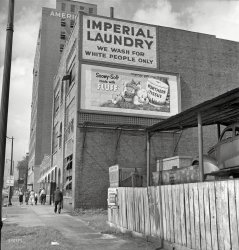
- Crossroads Store: 1936
- ... August 1936. "Crossroads store and post office. Sprott, Alabama." Last glimpsed here . 8x10 inch acetate negative by Walker Evans ...
Still There --
The 1940 Census of Sprott, Alabama Since this and the previously posted photo of Sprott are from ... Posted by Dave - 12/28/2022 - 12:16pm -
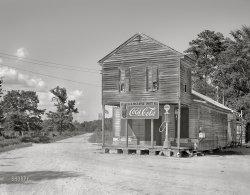
- Dixie Kitten: 1902
- ... 1902-1906. "Tuskegee Normal and Industrial Institute, Alabama. Branch & Vicinity School. Woman standing at gate holding a cat." ... Posted by Dave - 03/03/2024 - 5:34pm -
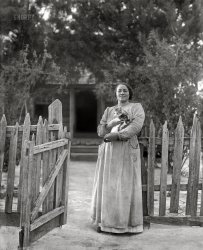
- Ghosts of Atlanta: 1864
- ...
Whitehall & Alabama My guess is the corner of Whitehall and Alabama Streets looking northeast. Currently Peachtree Street. Back then ... stood on the corner of Lloyd (now Central Avenue) and Alabama Street, at south angle. So I would guess that if we're one block west ... Posted by Dave - 07/31/2012 - 7:20pm -
![Ghosts of Atlanta: 1864 "The War in the West." 1864 photo (half of a stereograph) by George N. Barnard. Atlanta Intelligencer newspaper office by the railroad depot. Exposure times were so long that anyone walking appears only as an ectoplasmic blur. View full size. Note tents in background and troop train with soldiers atop the boxcars.
where was this in Atlanta?Anyone know where this was in Atlanta? Looking for an approximate street address.
Masonic lodgePerhaps the large masonic lodge in the background is still standing ... might be a clue.
Try the main PeachtreeTry the main Peachtree Street / locate the address of the Atlanta terminal at the time / try Five Points area / could it be near Kennesaw? good luck--former Atlanta area resident and interested in knowing as well.
Masonic Lodge (1864) in AtlantaI have been researching, and it appears that the Masonic Lodge, and another building called The Trout House were on Decatur St. in Atlanta.
Click on this link http://memory.loc.gov/service/pnp/cwpb/03300/03304v.jpg (Trout house beside Masonic lodge.)
Here is a site with several images of Georgia during the Civil War...scroll down to 1864, and you will see the listing for this picture.
http://www.cviog.uga.edu/Projects/gainfo/cwphotos.htm
Now I am off to find out if this Masonic Lodge is still standing.
Where was this in Atlanta? (answer)I have been checking around and asking around about where this area in this photo might be, and a new friend on an Atlanta school site gave me this information...
Quote:
"Decatur Street is one of the main 5 roads that leads to Five Points, which basically is the center of downtown Atlanta, and was the center of town at that time. I think, but not sure, based on that picture and some of the other photos of the Union troop encampments, etc, that the Masonic Hall and Trout House were pretty close to what is now 5 Points. Most of that area of Decatur Street now has been renovated over the last 25 years and is where Georgia State University is located. I am fairly certain that neither of these structures is there any longer. When I went to GSU in the 1960's, I travelled almost the length of Decatur Street to get there. I do not recall ever seeing either of them, even back then, at that time, and to date, much of that area was torn down with Urban Renewal funds from the feds. It was mainly run down buildings and older businesses. It is possible that one of those run down buildings may have been one of the structures. However, Decatur Street runs east for a few miles, and they may have been futher east than I think. During the Civil War era, though, most of that area was rural. The actual Battle of Atlanta that is depicted in the Cyclorama painting took place away from the center of town out in the rural area of Decatur St/Road & what is now Dekalb Ave.(same road).
At least this clears up a little bit for us all.
sherri
Underground AtlantaMy guess is that this was taken near the corner of Peachtree SW (then Whitehall) and Wall St. That would put it in what is now Underground Atlanta, I think.
Whitehall StreetWAR-TIME CAMP IN ATLANTA, GEORGIA, IN THE OLD CITY PARK
At the extreme left is the old Trout House, the principal hotel at the time; tracks of three of the chief railroads here crossed Whitehall Street, on which the "Intelligencer" office fronted.
http://docsouth.unc.edu/fpn/gordon/ill5.html
Whitehall & AlabamaMy guess is the corner of Whitehall and Alabama Streets looking northeast. Currently Peachtree Street. Back then Peachtree changed to Whitehall south of Five Point.
Atlanta DepotNoticed that the same photographer walked a block or so to the right after taking this one. Does that help narrow the location down?
Masonic LodgeBy the Masons' own records, the Lodge in the background stood on the corner of Lloyd (now Central Avenue) and Alabama Street, at south angle. So I would guess that if we're one block west it's on what is now Pryor Street or if two blocks Peachtree.
http://maps.google.com/maps?q=Alabama+Street+Atlanta&oe=&ie=UTF8&hl=en&h...
Ref: http://www.ap59.org/html/atlanta_59.html
HandbillIf you look on the corner of the building, you can just make out the word "frolic." Can't quite tell what comes before.
[Cobblers? Gobblers? - Dave]
Atlanta Intelligencer office I have mapped many of Barnard's photographs on this interactive map. This picture is marked as Pushpin 10.
The playbill pasted to the building in the foreground advertises a stage show by Union troops to raise money for Mrs. Rebecca S. Welch, whose husband and son (Confederates) were both killed in Virginia.
The Bottom of the Playbill Reads:
Benefit Night / Maj(?) I. Smith / Leader of the Band / of the 33rd / Mass. / The Laughable Pantomime / The Cobbler’s Frolic / at the Atheneum / tonight / Saturday /Nov. 5th
Location of this buildingThis building was located close to where the Peach Drop tower currently is, at Underground Atlanta. Because of the viaduct that created Underground Atlanta, it would have stood below the current street level. It was on Whitehall Street (now Peachtree).
(The Gallery, Atlanta, Civil War, Geo. Barnard)](https://www.shorpy.com/files/images/03359u.thumbnail.jpg)
- Rodah Horton House: 1934
- ... Rodah Horton in 1843 on the Meridian Pike near Huntsville, Alabama. The Greek Revival portico was added around the time of the Civil War. ... I have an old house like that. Maintenance nightmare.
Alabama Is that house still standing? I live outside Huntsville. Would love ... Posted by Dave - 09/05/2012 - 2:57pm -
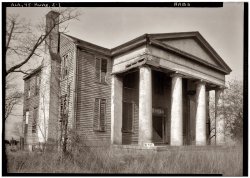
- Store Wars: 1941
- ... from Fort Benning in a country store near Phenix City, Alabama." Medium format negative by Jack Delano. View full size.
... 1955:
https://www.imdb.com/title/tt0048488/
Go Alabama! I just had to be the contrarian.
Everything you've heard ... Posted by Dave - 11/07/2018 - 10:27am -
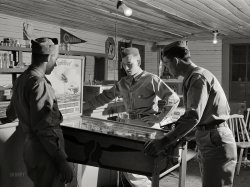
- Marietta Street: 1864
- ... in the photo.
That's not Marietta Street It's Alabama Street, facing east from the intersection of Whitehall.
[Any ... visible), and looking southwest down Broad Street toward Alabama Street. In the directory, you can find the Franklin Press (6 Broad), ... Posted by Dave - 08/09/2012 - 5:19pm -
![Marietta Street: 1864 1864. "Atlanta, Georgia. View on Marietta Street." Wet plate negative by George N. Barnard. LOC Civil War glass plate negative collection. View full size.
Purple HazeI wonder if one could buy a guitar at J C Hendrix ?
Wagon GhostAny idea what the white streak is?
[Like you say in the subject line, maybe a covered wagon passing by. - Dave]
What the building saidThe building across the street to the right says Furniture. What does the middle building say at the top? ["Franklin Printing House & Bookbindery" - Dave] Is there any way of telling what block of Marietta Street? And I would assume this picture was prior to the Nov. 11 fire.
November 11 fireThis photo must have been taken fairly close to that date, as the signs in the lower left corner advertise events (pantomimes are mentioned) taking place on November 8 and 10.
ExcitingTo take a peek back into history. I never take the wonder of photography for granted, and each and every picture is like a little piece of time saved.
Overhead AtlantaBelow is an aerial view of your photo -- the centre of a painting of 1864 Atlanta (presumably from sketches from a balloon) by Wilbur G.Kurtz. It appears in "Yesterday's Atlanta" by Franklin M.Garrett. Your photo is taken from right to left across the top of this bit of the painting. The big "car shed" is off to the left of the photo, which also seems to show a locomotive roundhouse at the end of the street, not shown in the photo.
That's not Marietta StreetIt's Alabama Street, facing east from the intersection of Whitehall.
[Any documentation to back this up? - Ken]
Marietta and BroadI've spent hours poring over the 1871 Atlanta city directory, and it's clear to me that this picture was taken from the corner of Marietta and Broad, with the photographer standing, elevated, on the opposite side of Marietta Street (which is not visible), and looking southwest down Broad Street toward Alabama Street. In the directory, you can find the Franklin Press (6 Broad), the S.B. Robson Broom company (Broad Street near Alabama), and the Grant Building (corner Broad and Marietta), which is home to many entities, including W.K. Fox Furniture. By 1871, J.C. Hendrix was an assistant secretary to the Georgia Senate; it appears that by that time, J.C. Hendrix & Co. no longer warranted an entry in the directory.
It's Alabama StreetI have mapped many of Barnard’s photographs on this interactive map. This picture is marked as Pushpin 7.
An earlier comment is correct; this is Alabama Street. Somewhere along the way it got mislabeled – probably due to the RR roundhouse in the background being confused with the larger Western & Atlantic facility in the other direction. Today, the ground level is Underground Atlanta.
(The Gallery, Atlanta, Civil War, Geo. Barnard)](https://www.shorpy.com/files/images/03462a.thumbnail.jpg)
- First National: 1905
- Birmingham, Alabama, circa 1905. "First National Bank, 20th Street." 8x10 inch dry plate ... still house offices.
It's a sunny noon-30 in Alabama and they are ready for snow! The heavy clothing people wore in those ... Posted by Dave - 11/12/2017 - 10:37pm -
![First National: 1905 Birmingham, Alabama, circa 1905. "First National Bank, 20th Street." 8x10 inch dry plate glass negative, Detroit Publishing Company. View full size.
On that clothingAs long as it's a worsted and not winter weight, a suit, even three piece, can be surprisingly comfortable until it gets very warm. For 30 degrees, the gentlemen would be wearing overcoats.
I'm personally guessing, moreover, that this is "not summer", as all over the South, men can and do buy linen blazers for June, July, and August. I see the ads every time I visit my dad near Hot Springs in the spring.
I am struck at how the building's owners allowed room tenants to choose their own sun awnings. You don't see much of that today--it's either all or nothing, and due to air conditioning, a lot of people simply use shades inside because they don't have to worry about how warm the sun is anymore.
+112 and it's still thereBuilt in 1903 at 205 20th Street North, it's now the Frank Nelson Building. Upper floors still house offices.
It's a sunny noon-30 in Alabama and they are ready for snow!The heavy clothing people wore in those days. I blame global cooling.
Seriously, can anyone explain?
The clothing.
[Cool temperatures. Wool. No polyesters yet. For starters. -tterrace]
Daredevil coffee break?How can we have a photo of a tall building without someone clinging to the outside?
WonderHow effective it was to have your office name on the windows of your office, 5 or 6 stories up in the air. Did folks walking below keep looking up to find you?
(The Gallery, Birmingham, DPC)](https://www.shorpy.com/files/images/SHORPY-4a13392a.thumbnail.jpg)
- High-Steppers: 1961
- ... like it.
Georgia Looks like Macon.
Sweet Home Alabama I'm thinking Birmingham. Down along 2nd Ave North.
The ... Posted by Dave - 08/26/2015 - 12:20am -
![High-Steppers: 1961 "Parade." Somewhere Down South circa 1961. Who can tell us where? 4x5 inch acetate negative from the Shorpy News Photo Archive. View full size.
Obvious isn't it?This is Main Street U.S.A. Every town had one just like it.
GeorgiaLooks like Macon.
Sweet Home AlabamaI'm thinking Birmingham. Down along 2nd Ave North.
The Martin TheatreIn the background, probably means Columbus, Georgia.
[Correct! - Dave]
Vampire flag corpsThey don't cast shadows, and there's something very odd about the perspective and depth of this photo. Could this be a composite?
[No; this is a scan of the original camera negative. Overcast skies result in extremely indistinct shadows. -tterrace]
Another AngleKAP beat me to the punch! This is earlier photo of the same block.
(The Gallery, News Photo Archive, Pretty Girls)](https://www.shorpy.com/files/images/SHORPY-594.thumbnail.jpg)
- Wedded Bliss: 1955
- ... Mr. and Mrs. Antonio Petruzella taken February 20, 1955 in Alabama (probably Birmingham). Most likely related to my mother-in-law, as her ... View full size.
I don't think we're in Alabama anymore Most of these old photographs have the name of the city or ... Posted by monkeeshq1954 - 03/01/2013 - 8:06pm -
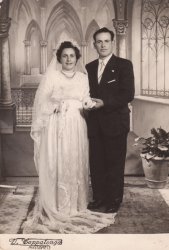
- King Midget: 1956
- ... in Chicago. It appears that Havva was his wife's name.
Alabama? The only Havva manufacturing plant I could turn up was in Phenix ... Posted by Dave - 05/01/2017 - 7:25pm -
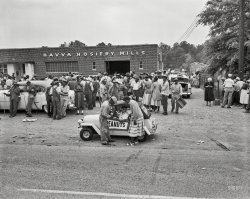
- Dogtrot (Colorized)
- ... depth and interest.
I don't think we're in Alabama anymore I love this. It has a rural "Wizard of Oz" feel to it. Not ... Posted by Sampiro - 09/19/2011 - 10:24pm -
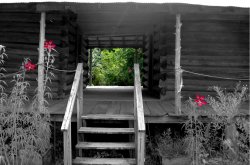
- Nashville: 1864
- ... how much longer can the war go on??? I live in Decatur, Alabama and it seems some still carry the war with them on some level? i love ... Posted by Dave - 10/21/2023 - 3:33pm -
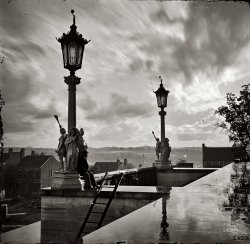
- TRX: 1910
- Mobile, Alabama, circa 1910. "Unloading bananas." Tropical Refrigerator Express reefers ... Posted by Dave - 09/19/2023 - 3:58pm -
![TRX: 1910 Mobile, Alabama, circa 1910. "Unloading bananas." Tropical Refrigerator Express reefers at the ready. 8x10 inch glass negative, Detroit Publishing Company. View full size.
Open Air Ship's WheelThis is likely an emergency wheel located close to the steering mechanism. The regular-use wheel is forward, in the bridge of this steamship.
BananasThis was about a decade into the long march of the United Fruit Company through Latin America, leaving in its wake "banana republics", untold injustices, and the lasting model for multinational corporations.
Open door policyI'm guessing that the reefers are in "ventilated car" mode, since bananas, while temperature sensitive, don't require the level of cooling some products do (namely frozen ones). The hatches are in the up position to facilitate air flow, rather than for icing.
Where's Harry?I don't see the tally man.
Norway?I can’t make out the name of the boat, and regardless it doesn’t appear that there’s a country listed, but the flag looks Norwegian to me. Does that even make sense?
Mr TallymanThe tallyman and his buddy are on post, they even arranged a bench to check the unloading in comfort.
The banana boat is NorwegianAs evidenced by the flag. It's from Bergen and its name ends in "DØ" The beginning is obscured by the flag
Ship's WheelI don't remember seeing a ship's wheel quite so exposed to the elements outside of a pirate movie.
Sidewheeler IDJas. A. Carney 1894 according to page 219 of the 1910 Annual List of Merchant Vessels of the United Stares
WHAT Bananas?I see coal and not bananas!
"Yes, we have no bananas?"
https://www.youtube.com/watch?v=8QqkrIDeTeA
or if you prefer originals:
https://www.youtube.com/watch?v=PDd8shcLvHI
Where's the Day-O?
Yes, we have no ...I'm banana blind -- not one in sight.
Yes -- bananas!Look carefully at the conveyor just above the righthand white ventilator. The conveyor consists of a series of slings, each one lifting a bunch of bananas.
Hellø BodøHere we see the diminutive 181-foot Norwegian steamer Bodø, launched as the Xenia in 1894 at Bergen by Bergens Mekaniske Versteder for Bergh & Helland of that city. At 666 gross and 398 net tons, it was powered by a triple expansion steam engine supplied by a Scotch boiler. It became the Bodø in 1899 and was chartered to the United Fruit Company to haul fruit, primarily bananas, between Jamaica and the the East Coast. United Fruit chartered many Norwegian vessels around the turn-of-the-last century beginning in 1899. Later named Plentingen, Polar, Samos and Ikaria, it was dismantled in Greece in late 1928. It has appeared before on Shorpy (as has a similar comment of mine!)
Gaillard-Johnson Coal CompanyFrom the 1909 Mobile city directory. When cities had more than one telephone company. Coalyard located at foot of St. Anthony. Phone Bell 248 or Home 51.
[City directories go back to before people even had telephones. - Dave]
Walking the GangplankAs a free-range kid in Mobile, I have personally watched bananas being unloaded from a ship, circa 1950. It was nothing like this photo. There was a slanting gangplank between the ship and the dock, and a continuous line of men descending with stalks of bananas over their shoulders. I recall the gangplank being wooden, but am not sure of this.
Nor do I recall how the men got back on board, but obviously they did.
“Lighter”I’m interested in the boat off to the right of the ship. It’s actually a barge called a Lighter. These were, and in some cases still are, used to service ships in port. In this case the Lighter is providing coal to fuel the steam boilers. It has never been clear to me where the term came from. Some have suggested it’s from the German “Lichter” as some barges were used to off load (lighten) small deliveries to shore from large ships.
Another great photo.
Source of photo?The source of this great photo is described as Detroit Publishing Co., Library of Congress, but I am unable to find this photo at the Library of Congress website. Could someone provide me with a link to the photo? I've tried every search term I can think of.
[This was one of a group of hundreds of damaged glass negatives added to the LOC archive in February. They have yet to be captioned, so will not show up in search results. - Dave]
(The Gallery, Boats & Bridges, DPC, Mobile, Railroads)](https://www.shorpy.com/files/images/SHORPY-4a55225a.thumbnail.jpg)
- Whitewash: 1935
- 1935 or 1936. "Negro cabin in Hale County, Alabama." View full size. 8x10 nitrate negative by Walker Evans for the ... hand. It is awaiting a place to be rebuilt now.
My old Alabama home That is a "slab house" as they called it when I was a young'un ... Posted by Dave - 09/08/2011 - 9:45pm -
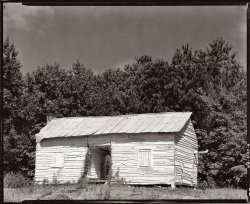
- Shorpy Higginbotham: 1910
- ... Bessie Mine, of the Sloss-Sheffield Steel and Iron Co. in Alabama. Said he was 14 years old, but it is doubtful. Carries two heavy pails ... He worked for Tennessee Coal and Iron in Jefferson County, Alabama. After his back was broke in a mine accident and suffering from years ... Posted by Dave - 02/14/2022 - 3:03pm -
![Shorpy Higginbotham: 1910 December 1910. "Shorpy Higginbotham, a 'greaser' on the tipple at Bessie Mine, of the Sloss-Sheffield Steel and Iron Co. in Alabama. Said he was 14 years old, but it is doubtful. Carries two heavy pails of grease, and is often in danger of being run over by the coal cars." Photograph and caption by Lewis Wickes Hine. View full size.
Shorpy storyThe story about this boy makes me so sad. The photo is so strong. Esthetically - wonderful - artistic movie like.
Thanks for sharing it with all of us. Tamara Razov.
His armsThose are the roughest part--it appears that they're rather permanently in that position.
Notice His Hands...You can tell Shorpy worked very hard. His hands look like the hands of a 40 year old man, not a 14 year old boy. His arms do appear to be permanently bowed out and his shoulders are sloped from carrying the heavy buckets.
How we could ever have gotten to this point in our society is beyond me. Thank goodness for the progressive people back then who put a stop to such practices and gave kids like Shorpy their childhoods.
omg. after seeing theseomg. after seeing these pictures, its so hard to believe how far we have gone and what todays world is like compared to back then. The question is, what would they think if they saw what the world was like today and how people are living?!
(perfect example, we now have cars that drive for us!!!)
Shorpy and child laborThe pictures were taken only 30 years before I was born.
When I was 14 I needed a State of California Work Permit in order to get a summer job (picking cotton).
We could quit school at 16. I didn't do that but many did.
Thank God for the reformers in the early 20th century!
"The golf links lie so near the mill that almost every day, the working children can look out and watch the men at play."
Don
Lest we forgetIt is easy to forget from the perspective of our comfortable North American lifestyles that in many places in the world, child labor still runs rampant, not because families want their children to work endless hours in deplorable conditions, but because their very existence depends on the meager income the children earn. Let's not become too complacent and self-satisfied that we've "progressed" beyond the conditions of the early 20th century until we've globally eradicated those same conditions that continue to exist today.
picture from a greaser kid... ... cause of his size he was able to easily go inside all the mechanics stuff.. they see it as a game... some great technologics developments were the outcome of that work-players boys... thats the good one... the bad one is that some of them never play again...
So great wonder!Really I'm so scare about you beautiful eye-moment, serious, I think in a lot of stuff's, that amazing like a time capsule... Don't have the exactly words for tell you my reasons... make my day theses snaps.
I hope back soon.
Carlos "Cx"
Shorpy's contemporariesA ten-year-old working in the mines was not unusual. My grandfather was born in 1896 and started in the mines at age ten. He worked for Tennessee Coal and Iron in Jefferson County, Alabama. After his back was broke in a mine accident and suffering from years of black-lung he lived to 84.
This was before welfareAmerica is still the greatest place in the world to give. I have traveled to a lot of countries. Yes, they have their pluses, but even the poorest americans live better than 99% of the worlds population.
Shorpy HigginbothamI wonder if anyone knows where Shorpy Higginbotham's grandfather, Robert Higginbotham, is buried.
Robert Higginbotham is my Great Great Grandfather.
Kenny Brown
twotreesklb@aol.com
Shorpy, descendant of Revolutionary War SoldierShorpy was my father's (Roy Higginbotham's) uncle, a younger brother of my grandfather, John W. Dolphus Higginbotham. Their ancestor Robert Higginbotham was a Revolutionary War soldier who fought in the Battle of King's Mountain. He died in Huntsville, Alabama, where he farmed for many years. He is buried on his farm and the Huntsville D.A.R. had a ceremony a few years ago at his grave site. There is another Robert B. Higginbotham (also a descendant of Robt. Sr.), buried in Remlap, Alabama, I think, but I don't recall him having an intact headstone.
[P.H., thanks for the information. You have a fascinating family history. - Ken]
ShorpyI found him, he is one of my cousins. Henry Sharp Higginbotham b 23 Nov 1896 d. 25 jan 1928, son of Felix Milton Higginbotham and Mary Jane Graham. We descend from the Amherst Co. Virginia Higginbothams. my line was Benjamin Higginbotham who m. Elizabeth Graves and d. 1791 in Elbert Co. GA. Then his son Francis Higgginbotham m. Dolly Gatewood. When they were in old age they moved with with their sons to the new Louisiana Territory, E. Feliciana Parish. My gggfather was Caleb Higginbotham and gggmother was Minerva Ann Bryant of the Manakintown, VA hugenot BRIANT. All the Higginbothams and Bryant sons fought in the Rev. War. My gggg William Guerant Bryant and his brother John, his father, James and Uncle Isaac and Isaac's son James and His Uncle Thomas were all in the battle of Guilford Court House NC 25 Mar 1781. Thomas was killed and Isaac wounded in the head.
Bessie Mine?One of the first posters said that Bessie Mine may still be operational. Is that true? When I look it up online, nothing much comes up. I'd love to see some more pictures of the mine, though, and learn a little more about it!
Bessie MineBessie Mine appears to be closed. Information available online shows that the current owner, US Pipe, has filed an application to use the area as a landfill.
My grandfather worked at Bessie and other mines in west Jefferson County. He would have been about Shorpy's age but didn't start to work there until he was 18 or so. After a couple of years working in the pits, he was able to get a position tending the generators and never had to work underground again.
Then and NowI don't want to go back to the "good old days." But everybody should "work" at least a few days (e.g. move a lot of force through a lot of distance all day while either sweating or freezing, dirty, dog-tired, with something aching). Maybe a kid who did some of this stuff will better appreciate the real things in life rather than Britney, American Idol, text messaging, and Fifty-Cent rap.
I'm glad i did - but not too much! In my younger days, I harvested tobacco, hauled hay, milked cows, moved gravel from a creek bed to the barnyard in a mule wagon, picked potatoes behind a mule plow, budded peach seedlings and harvested nursery stock on cold rainy January days. These are cherished memories working with my kinfolk on their farms. I'm glad I did it!
I've rolled cement up a hill in a wheelbarrow and finished it, framed and built buildings, plumbed and wired, and swapped greasy motors in cars. It all pays off as I can save money as a do-it-yourselfer. And it paid off as an incentive to study and go to college so I didn't have to do it for a living!
Looking at these pictures, I don't feel sorry for the people in them as I don't think they knew how "bad off" they were. So they were not! However, I have a tremendous amount of respect and admiration for our hard-working ancestors, my aunts and uncles, and cousins.
Roy HigginbothamWas your father the Roy Higginbotham who was principal of Minor Elementary School in the 60's and 70's?
martyshoemaker@hotmail.com
Bessie Mine Locationhttp://maps.live.com/default.aspx?v=2&FORM=LMLTCC&cp=33.657286~-87.03305...
Clyde Donald HiggI am also related to the Higg from Va, and also the ones from Ireland. I just loved this about Shorpy Higg. I am still trying to locate more information on the Higg from Ind. where my father was from, his father was Luther, and his father was George. My father's name was Clyde Donald Higg.
cindykpiper@aol.com
[So you mean Higg, or Higginbotham? - Dave]
Feel sorry for us!>> Looking at these pictures, I don't feel sorry for the people in them as I don't think they knew how "bad off" they were.
I don't feel sorry for them either. I feel sorry for us, the younger generations. We have no idea what real, consistent hard work is. With the way things are going I desperately want to know someone who has lived the hard life, maybe lived through the Depression but no one is around to glean from. I just turned 33 years old but I see the wisdom in searching out the generation. I have even written my husbands Grandmother for advice but she is too busy to share her knowledge. I don't wish evil for our great country but it might do us some good to have to experience hardship to get our act together. For me, I grew up without hot water, sometimes the electric was shut off, rarely a car and I can tell many a story about cleaning clothes in a wringer washer in the middle of Missouri's wicked winter temps - outside at that. But I still know I have so much more to learn.
Roy Higginbotham>> Was your father the Roy Higginbotham who was principal of Minor Elementary School in the 60's and 70's?
That particular Roy Higginbotham was not my father, although I had heard about him from my cousins who still lived in the area. No doubt he is related in some way. My father (Roy) was also a coal miner in his younger days like his father and uncles. He died in 1961 at the age of 46. I remember my grandfather John talking about his brother "Sharpe" and how someone "took his picture" when he was a young boy working in the mines. Sorry it took so long for me to reply.
Bessie MineI live a few blocks from the mine. It was just off Rt 150 in Bessemer. The mine complex was left intact and abandoned since the 1950's until the buildings were cleared in 2009. I did photograph it before it was destroyed.
Happy Birthday Shorpy!Thank you for diligently updating and uploading. I know it takes a lot of time to run a website like this, and I for one am grateful for your efforts, Dave.
Thank you!
Shorpy Higginbotham: 1910This is Joe Manning, of the Lewis Hine Project. For those who have not seen it, here is my story of Henry Sharp Higginbotham.
http://morningsonmaplestreet.com/2014/11/26/henry-s-higginbotham-page-on...
Happy Birthday, Shorpy.com!I've been visiting since day one, so what else can I say? I love this site! Keep up the great work!
Daily DoseHappy Birthday Shorpy! You are a part of my daily ritual since you began and I look forward to checking this site as often as time permits. I've learned a great deal since you began these wonderful posts. Thanks gang, and many more!
My 2 cents worthI'm just a pup here, having only been on board for a year and a half. Thank you Dave, Ken, tterrace and all who do such a great job on this site.
To all the Shorpyites who add so much extra via comments, links and other added information, you all get a big "Attaboy". Thanks to one and all.
Happy birthday!
Thanks for a Great Five YearsYour very skilled and hard work, along with your thoughtful selection of the right moments from the past is greatly appreciated, Thank You!
George Widman
A treat each and every dayA great website that really is quite a treat each day,and I never can wait until another post,and the comments are always entertaining. Thank you for 5 years of hard work. I know I used to blog and I know it's something you dedicate yourself to.
The best photo blogI'm so glad you've kept it going. Yours is the best one out there. I enjoy how your selection of photographs cover the gamut. They may be from a particular era but not from a particular style or emotion.
RemindersThanks to you all for these incredible photos--wonderful work! Some remind me of my own childhood in the south and I have photos, too. My grandmother worked in a textile mill when she was 12, around 1912, never had much schooling, and married at 16. She told me stories of the Depression, when she had 6 children to raise by herself. A wonderful person who was a huge presence in my life, esp when my mother died in 1948, poor and in ill health. In 1955, my first job was at the five and dime at age 14 on Fri night and all day Sat for a grand total of $4.50.
Thank you again for the reminders of how it used to be, although I wouldn't want to repeat history.
Thanks!Thank you Shorpy and thank you shorpy.com
Fast Math"photographed by Lewis Hine 117 years ago"
107 plus 10 years of blogging, er, fast-forwarding gets you 117. Still the best site on the web.
Shorpy is my Great UncleHi my name is Timothy Williams, great grandson of Joseph James Williams, who was husband of Susie Higginbotham-Williams, sister of Henry Sharp "Shorpy" Higginbotham. Oddly as it may sound; although, probably not shocking, I think my family might have married into the Higginbotham's more than once. My father was a Williams and my mother was a Higginbotham too.
Anyways, It is my honor to share this with you all and I am happy to have found this website and I am so happy to look upon these pictures of one of my family members. I am proud to know he is my kin. While I am not a historian, I have majored in enough history classes, that I could probably teach it at some level. My family ancestry dates back to England and Scotland. I have a Robert B Higginbotham in my family that the Daughters of Revolution, found a grave marker years ago. He was a Revolutionary War hero. I don't know how they would be related, even if they are.
https://www.findagrave.com/memorial/28768283/robert-higginbotham
(The Gallery, Kids, Lewis Hine, Mining)](https://www.shorpy.com/files/images/01097u2.thumbnail.jpg)























